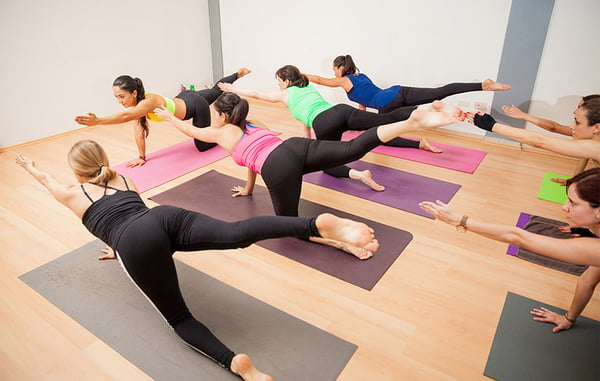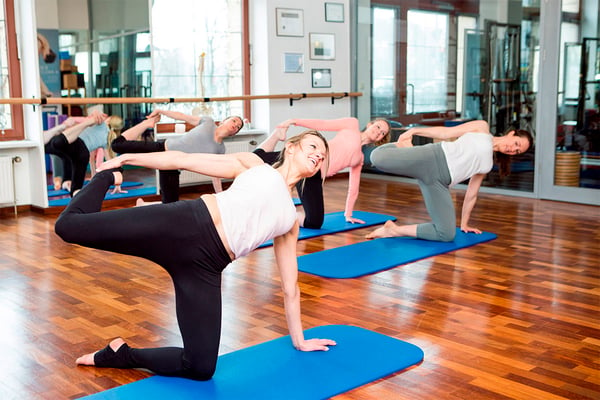
While your group fitness students are enthusiastic about getting stronger and improving their endurance, they may not be aware that, in addition to focusing on strength, cardiovascular conditioning and mobility, they should be including balance training in their workouts.
Good balance improves performance and increases body awareness and coordination. Share this with your students and incorporate balance training into your next class.
This article originally appeared in the Fall 2020 Issue of American Fitness Magazine
Balance Training Benefits
There are many benefits to balance training, including (but not limited to) the following:
ATHLETIC PERFORMANCE
The ability to control body position while moving is essential to an athlete’s success. Dynamic balance—the ability to change direction without falling—is affected by speed, endurance, flexibility and strength (NASM 2018). When practicing and repeating new skills that enhance balance, the nervous system creates connections that make athletic movements easier to execute, leading to better performance.
ACTIVITIES OF DAILY LIVING
Good balance skills translate to greater ease in daily life. What are your students’ performance goals? Participants don’t necessarily need or want to be athletes! Perhaps they want to carry groceries, play ball with their kids or walk on uneven terrain. These tasks all require balance.
When people engage in these kinds of activities, the neuromuscular system processes information from the senses and “communicates” body position. Practicing and refining the ability to interpret this information—with basic moves, in a controlled training environment—promotes functional fluency, paving the way for participants to safely enjoy their daily activities.
FALL PREVENTION
The risk of falling is a common concern among older adults. If you instruct seniors, include simple balance challenges in addition to strength and mobility moves. Strengthening the stabilizing muscles that support the joints improves one’s ability to move independently, maintain an upright posture, and more quickly and automatically respond to changes in body position.

Practical Applications
If you’ve tried introducing balance training to your students, you may have found that it is not always well-received. Elizabeth Lenart, owner of Studio E Fitness in Chicopee, Massachusetts, and national program director for Balletone™, suggests starting small. “Selling this concept to your students is like selling broccoli to your kids,” she says. “Start by sneaking it in. Let them get a taste of it. Once they begin to experience the many benefits, they’ll appreciate the results.”
Gioia Gensini, an AFAA-certified instructor and ACE-certified health coach from Syracuse, New York, agrees. She includes balance in all her classes. “I enjoy integrating balance into the warmup, movement preparation and cooldown portions of my class,” she says. “I do this in a variety of ways, with and without equipment, and utilize all planes of motion. My students have begun to appreciate the functional benefit, whether they’re looking to enhance their athletic performance or trying to maintain their level of daily activity.”
Tap into your creativity to provide your class participants with all the tools they need to improve movement quality, while also focusing on the formats they already know and love. Let’s review how to incorporate balance into popular programming.
HIGH-INTENSITY INTERVAL TRAINING
HIIT includes bouts of challenging cardiovascular exercises that alternate with recovery periods, during which participants simply rest or do a few lower-intensity movements. Recovery intervals may be the perfect opportunity to introduce body-weight exercises that challenge balance. Try the following moves between cardio cycles during your next HIIT class:
QUADRUPED BALANCE AND SHOULDER TAP
• Begin in quadruped position, hands directly under shoulders and knees beneath hips.
• Turn toes under and lift knees slightly off floor.
• Reach one hand to opposite shoulder and return to starting position. Alternate sides.
• Regression: Keep knees on floor.
• Progression: Do several reps on one side.
• Alignment tip: Keep hips level.
SINGLE-LEG ROMANIAN DEADLIFT
• Balance on right leg.
• Hinge from hip while extending left leg. Torso and rear leg are parallel to floor.
• Return to starting position.
• Repeat, other side.
• Regression: Keep rear foot on floor, slightly behind base leg.
• Progression: Reduce tempo.
• Alignment tip: Maintain extended spine throughout movement.
CIRCUIT TRAINING
Circuit training involves executing a series of exercises with limited or no rest. Quick and efficient, this format can easily fit into your schedule as a short and challenging “express” class. Offer balance challenges by including unilateral dumbbell exercises. When you load one side of the body, you recruit additional muscles to maintain proper alignment. Try the following options:
UNILATERAL QUADRUPED REAR FLY
• Start in quadruped position, holding dumbbell in R hand.
• Extend L hip so leg is parallel to floor.
• Abduct R arm to shoulder height, elbow slightly bent.
• Return to starting position.
• Complete 8–10 reps.
• Repeat, other side.
• Regression: Reduce range of motion.
• Progression: Start in plank position.
• Alignment tip: Keep shoulders level to avoid rotation.
SINGLE-ARM BENCH PRESS
• Begin supine on bench, feet flat on floor.
• While holding dumbbell, extend R arm so wrist is directly above R shoulder.
• Lower dumbbell, bring elbow to 45-degree angle from rib cage, wrist over elbow.
• Press back up to starting position.
• Complete 8–10 reps.
• Repeat, other side.
• Regression: Reduce amount of resistance.
• Progression: Begin with feet off floor, knees over hips.
• Alignment tip: Resist rotating when lowering dumbbell.
MINDFUL MOVEMENT
In addition to improving mobility and muscular endurance, many yoga poses require muscles to work synergistically to stabilize the body and control movement. Lenart says balancing also requires a strong mental focus. “Our participants really have to stay present,” she says. “There is no way to be on autopilot when working to stabilize the body.” If your students enjoy a mindful approach to reaching their fitness goals, consider including some yoga poses in whatever classes you teach. These additions may be especially appropriate if you work with seniors.
BALANCING MOUNTAIN POSE
• Stand with feet hip-width apart, arms at sides.
• Inhaling, reach arms overhead while lifting heels to balance on forefeet.
• Return to starting position. Repeat 8–10 reps.
• Regression: Hold onto chair to help with stability.
• Progression: Decrease tempo.
• Alignment tip: Engage core to maintain neutral spine.
SPINAL BALANCE POSE
• Begin in quadruped position, hands directly under shoulders, knees beneath hips.
• Extend R leg until it’s parallel to floor, while lifting L arm to shoulder level, elbow extended.
• Return to starting position.
• Repeat, other side; 8–10 reps.
• Regression: Perform without shoulder flexion.
• Progression: Do several reps on one side; repeat, other side.
• Alignment tip: Maintain level hips throughout movement.
EQUIPMENT-BASED CLASS
There are many equipment options to choose from, including balance pads, suspension devices, balance trainers and stability balls. These tools challenge stabilizing muscles to maintain proper alignment and body position. Gensini recommends providing modifications so that everyone is successful.
“When working on an unstable surface, I always start with basic skills that offer more points of contact, then have people work up to more challenging variations when they’re ready. Allowing time to get comfortable when working with balance challenges is essential. Once [moves are] familiar, I layer in progressions, such as visual tracking and unilateral moves.”
Here are some basic BOSU® Balance Trainer exercises that will challenge your participants in new ways:
BIASED SQUAT
• Begin standing on dome.
• Step R foot to side and lower into squat position.
• Return to starting position and repeat, L.
• Complete 8–12 reps.
• Regression: Hold weighted bar vertically for additional contact point.
• Progression: Increase ROM.
• Alignment tip: Track knees toward toes.
V-SIT WITH BICYCLE
• Start seated on center of dome, hands on either side of hips.
• Lean back slightly. Lift feet so shins are parallel to floor.
• Extend R knee.
• Bring R knee back to starting position while extending L knee.
• Repeat, 8–12 reps.
• Regression: Reduce ROM.
• Progression: Do V-sit with hands off dome.
• Alignment tip: Keep spine extended.
Brush Up on Your Balance
Take your teaching techniques to the next level with NASM’s Balance Training Course, offered online. Explore and master more than 100 exercises for optimizing balance and kinetic chain stability. Learn how to assess, build and implement balance-training progressions. Find out more at nasm.org/products/CEU1109006.

REFERENCES
National Academy of Sports Medicine. 2012. NASM Essentials of Personal Fitness Training (4th ed.). Baltimore, MD: Lippincott Williams & Wilkins.


